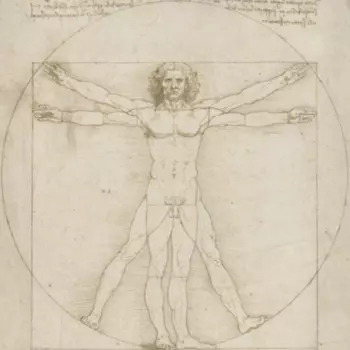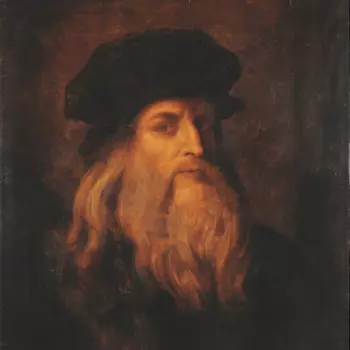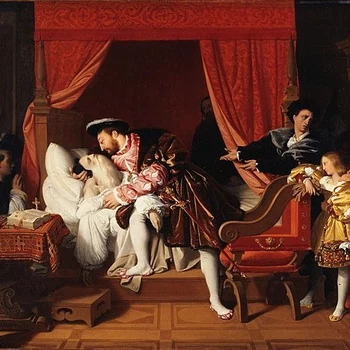Leonardo da VinciInventions
What did Leonardo da Vinci invent?
Leonardo da Vinci invented, among other things, various flying machines, a helicopter, the parachute, a tank, a steam cannon, an automobile, water walkers, a submarine, a diving suit, and even mechanical robots. Even though many of his inventions existed only on paper, his sketches inspired numerous researchers and scientists around the world.
How many inventions did Leonardo da Vinci invent?
Leonardo's notebooks show and describe over a hundred mechanisms, devices, and apparatuses that are considered the first mentions of their kind. However, it is important to note that not all of these inventions were made by Leonardo himself. He was very interested in technology and also sketched those things that he did not develop himself, but found useful. To find out which mechanisms, devices and apparatuses were actually developed by Leonardo is still the subject of the history of technology today.
The myth of the inventor
Leonardo da Vinci's inventions are transfigured into a myth today. In the popular literature then, Leonardo's ideas and ingenuity are often emphasized, but at the same time it is claimed that his apparatuses could never have worked as they did. Still others say that many of the inventions for which Leonardo is praised today were actually inventions of others and that he only copied them. And both are true.
Could Leonardo's inventions work?
Leonardo always carried a sketchpad with him, because ideas often came to him in everyday life, which he wrote down and drew without further explanation. These could also be cursorily sketched models of apparatuses, but not with the claim to be rebuildable. He made these notes only for himself, because while sketching the ideas he thought about their feasibility. If he was then back in his workshop, he put these notes aside and it could happen that he never looked at them again, because he had no more time for them due to other tasks and thoughts or because no practical application purpose resulted from them. This explains why many of his sketches were never put into practice. Conversely, however, it could also become, for example, a large building project, an automaton for a princely feast, or even a painting.
Leonardo's notebooks, called codices, have been partially preserved. Today, the approximately 6,000 pages are distributed among museums in Spain, England, France and Italy. Most of the codices have been digitized and can be viewed online. In 1994 Bill Gates acquired Leonardo's only privately owned manuscript, the Codex Leicester.
Did Leonardo copy the ideas of others?
Leonardo, as a Renaissance scholar, owned an extensive library. In it were various contemporary books, but also works of ancient scholars and engineers such as Plato, Euclid or Archimedes. Leonardo da Vinci, a Renaissance scholar, tried to capture the knowledge of the world known at that time. The contemporary as well as the lost and at that time disparagingly regarded knowledge of the Greek-Roman antiquity. So Leonardo knew many inventions of his and earlier times, dealt with them mentally and tried to improve them where it was possible for him. He had the ambition to collect all known knowledge of his time, to reduce this knowledge to the principles and to develop them further based on this.
Leonardo was also very well connected in the scientific world of Europe, which led to a constant exchange of ideas. From today's perspective, this can give the impression of plagiarism. But from the point of view of the Renaissance scholars, it was precisely a matter of taking up excellent ideas of others, spreading them for the purpose of a common progress of mankind and, in the best case, even improving these ideas. A climate of interdisciplinary scientific exchange developed. In this respect, Leonardo da Vinci copied ancient as well as contemporary ideas, but often also developed them further.
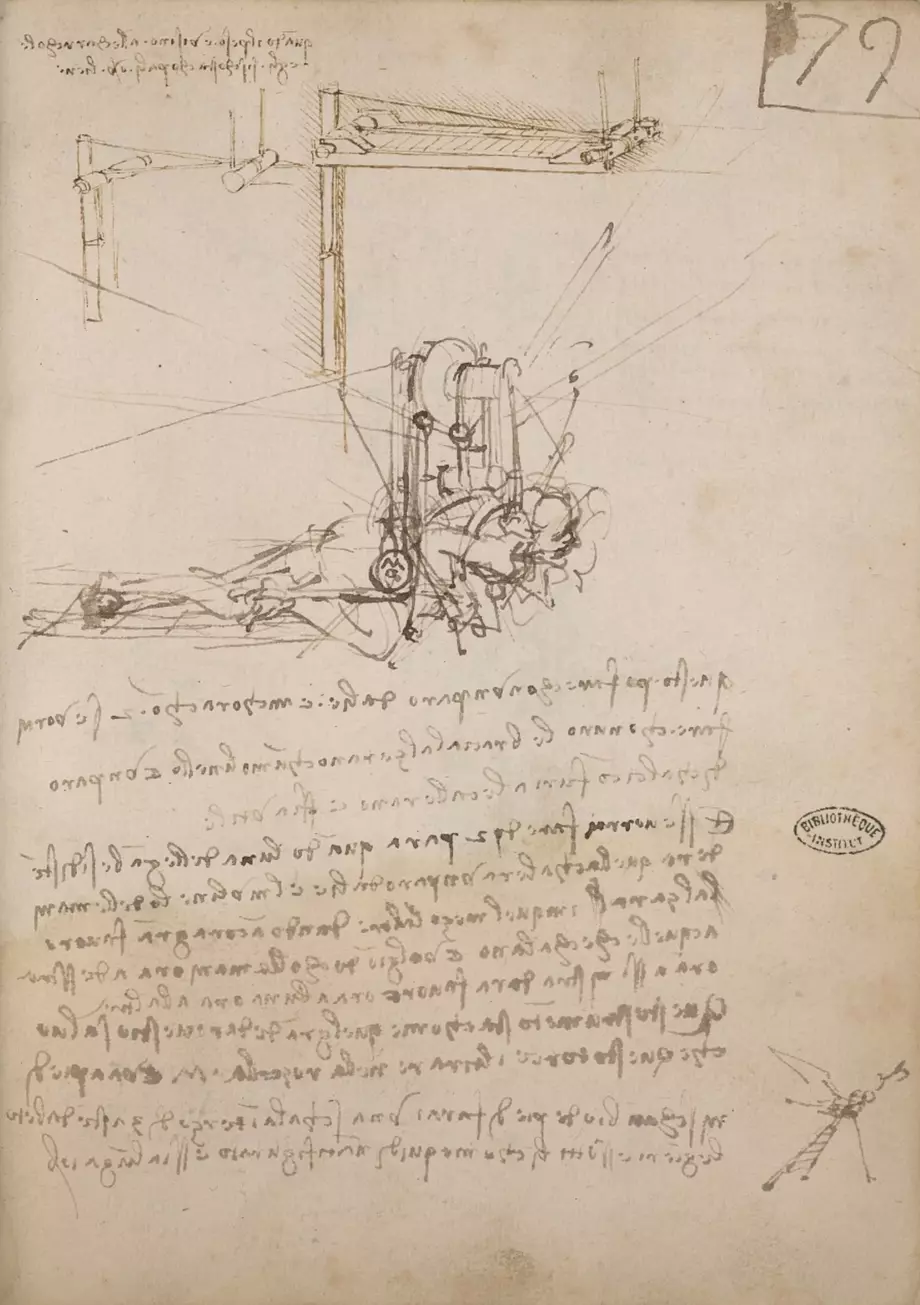
Leonardo's flying machines
Leonardo da Vinci
Study for a flying machine with hand and foot driven mechanism, Paris manuscripts (manuscript B, folio 79)
around 1487-1490
Pen and ink on paper
16 × 23 cm
Institut de France, Paris
Leonardo's flying machines are certainly among his most famous ideas. Throughout his life, he was preoccupied with the idea of being able to fly like birds.
Book about the flight of birds
Leonardo observed very closely the flight of birds and made considerations about it. He summarized his findings around 1505 in the 18-page "Book on the Flight of Birds", also called Codex Turin. This short work, along with the book on painting, is one of Leonardo's few thematically coherent manuscripts. Presumably, he wanted to publish it.
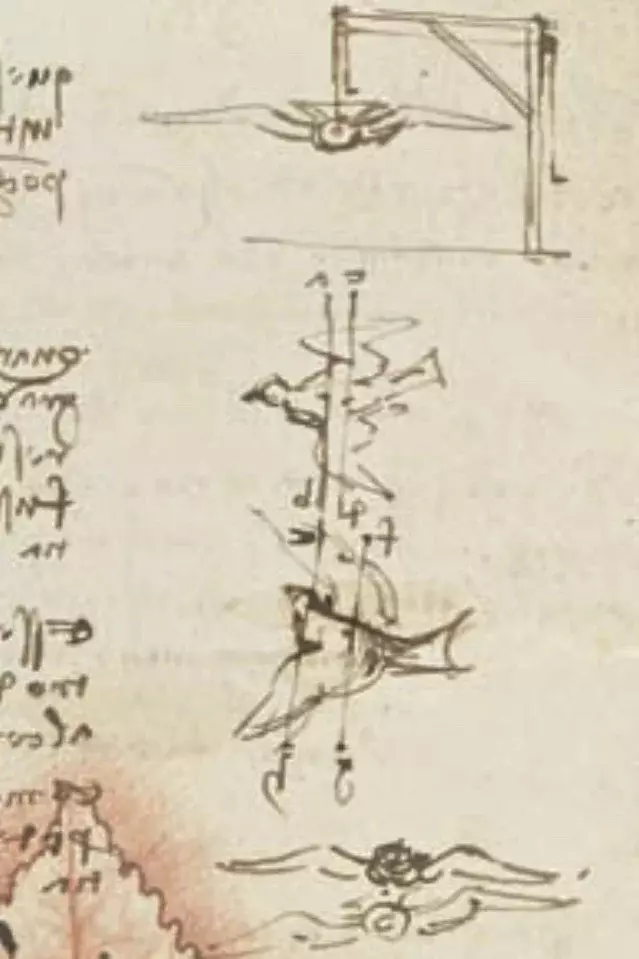
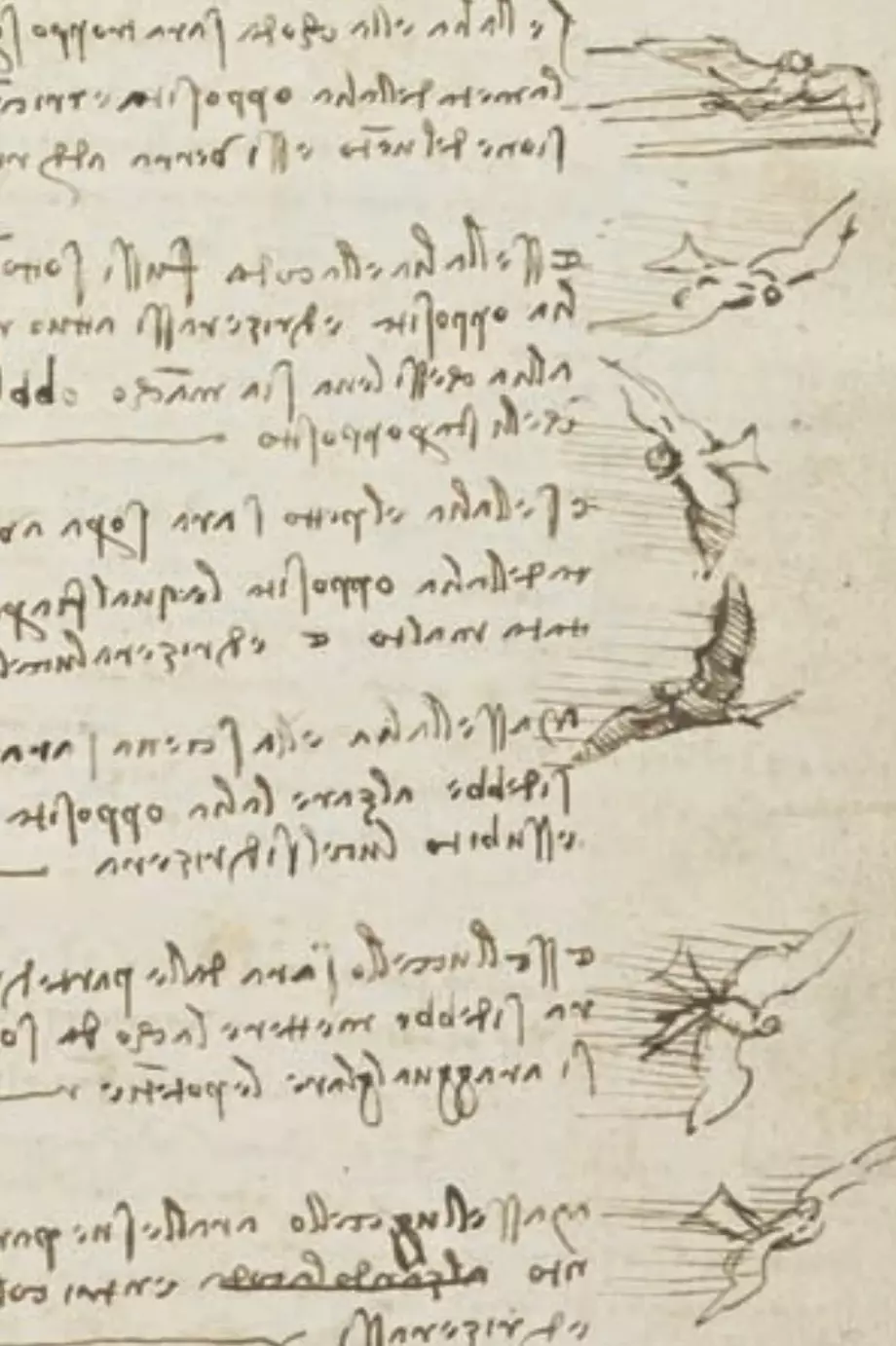
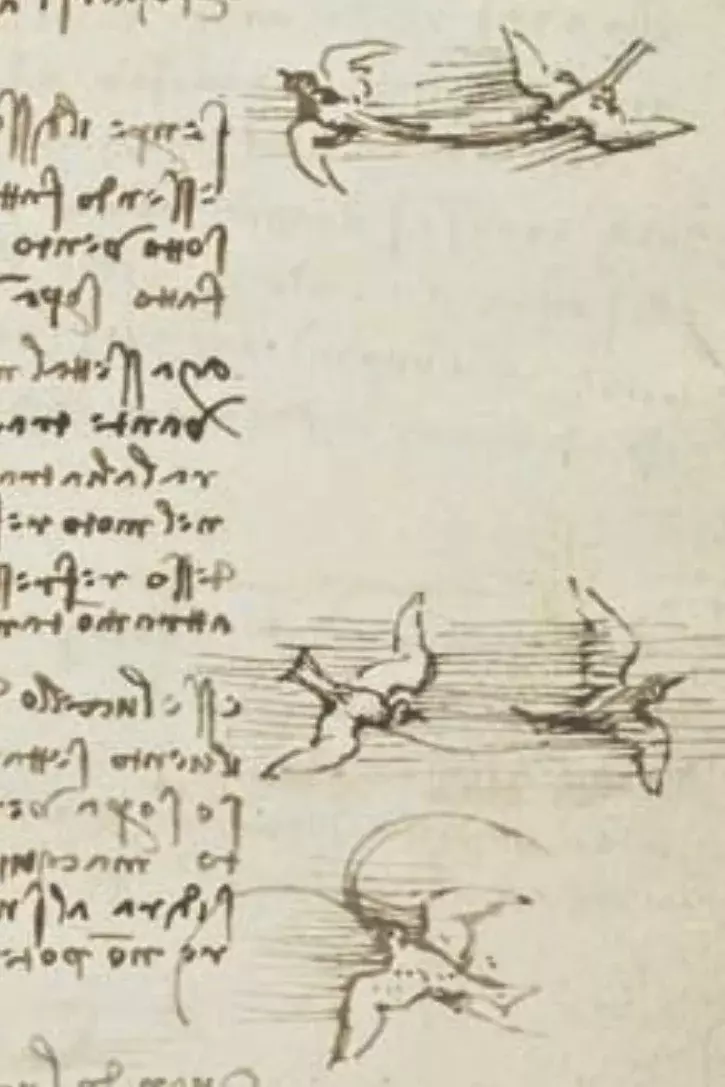
Bionics
Leonardo designed the wings of his flying machines based on the natural shapes of the wings of flying animals, such as birds and bats. He is therefore considered the inventor of bionics, the transfer of principles from nature to technology.
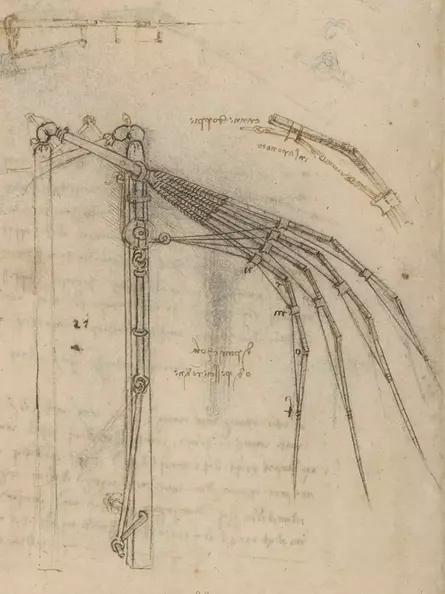
The articulation of the wing is modeled on a human hand, the spaces between which were to be covered with fabric. Here we can see how much Leonardo thought in analogies

The shape of the lower wing resembles that of a bat. Above it can be seen that the wing should be foldable as well
Drive
Leonardo initially intended his flying machines to imitate the flapping of birds' wings. Such flying machines are called ornithopters. For this purpose he created two versions, one standing and one lying. The wings were to be moved by human muscle power via ropes, pulleys and mechanical joints. The arms were to be used as well as the legs. When Leonardo realized that sheer muscle power would not be enough, he began to design gliders.
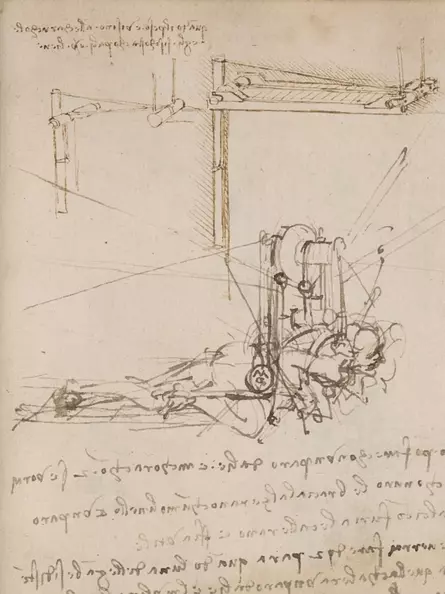
Leonardo writes that the arms should raise the wings by means of a winch and the feet should lower them by powerful heel kicks.
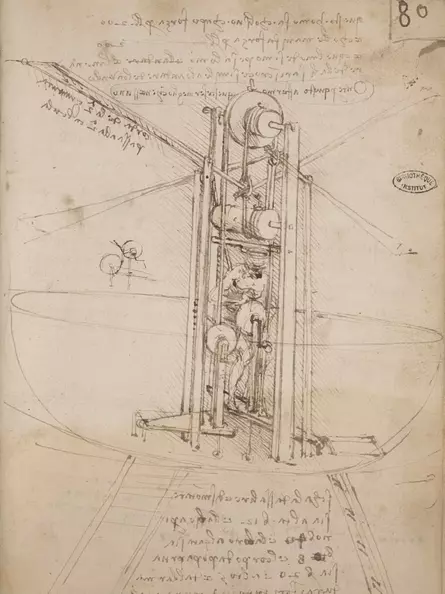
Here four wings are to be set in motion crosswise with arms and legs. Leonardo recommends a trial over a lake as a precaution. In addition, a long belt made of wineskins should be carried to avoid drowning in the event of a crash.
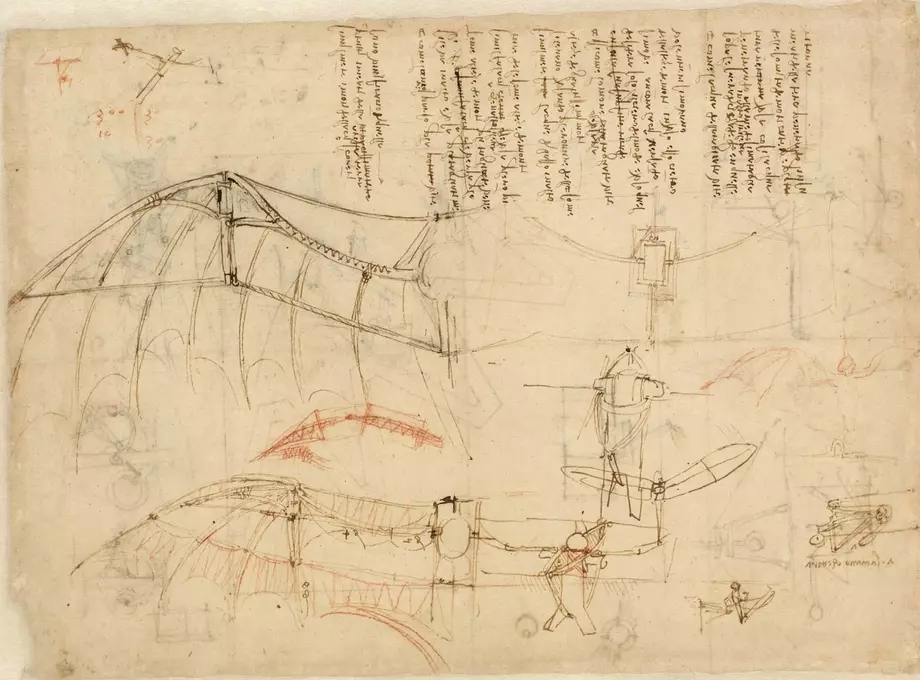
Note: The sheet is one of the few pieces of Leonardo's writing that is not written in mirror writing. Also, the lower part of the sheet deviates stylistically from Leonardo's other depictions. Especially the red lines seem to be added later.
After Leonardo realized that a flying machine moved exclusively by muscle power was not feasible in his time, he went on to design gliders in which the wings were rigidly connected. Here, only the ends can be moved, presumably to steer the aerial vehicle.
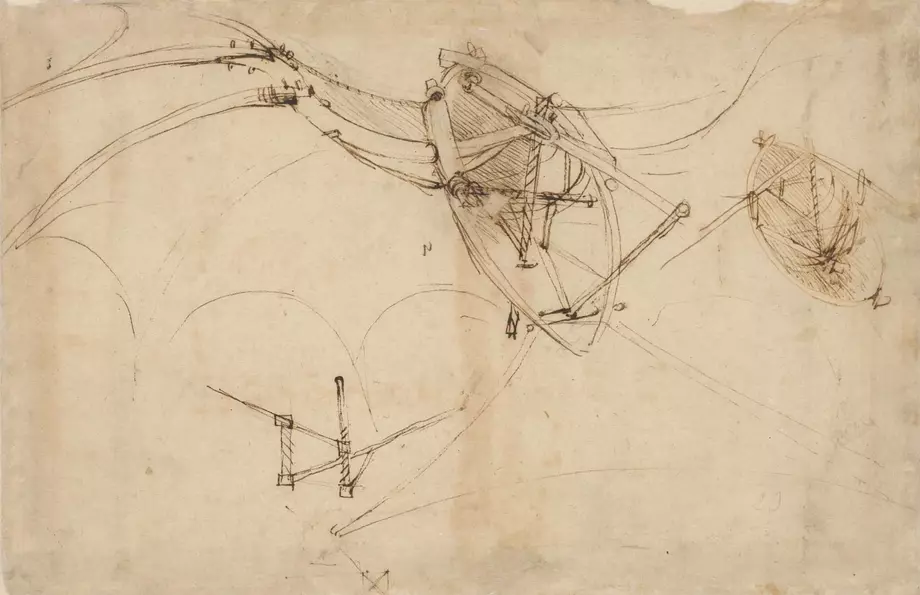
In this model there is no propulsion, only a control of the wings can be seen. Leonardo's analogy-based thinking is evident in the shape of the hull, which is reminiscent of a boat. Presumably he was already thinking of transferring the principles of aviation to his underwater vehicles, or vice versa
Leonardos Airbag
To prevent injury in the event of a crash landing, Leonardo recommended that pilots be clothed in air bags. This was to cushion the impact from low altitudes and thus prevent serious injuries. The then novel principle of cushioning violent impacts with yielding air cushions is now known as an airbag. Airbags are used in modern cars to protect the occupants from impacts against the vehicle interior in the event of an accident.
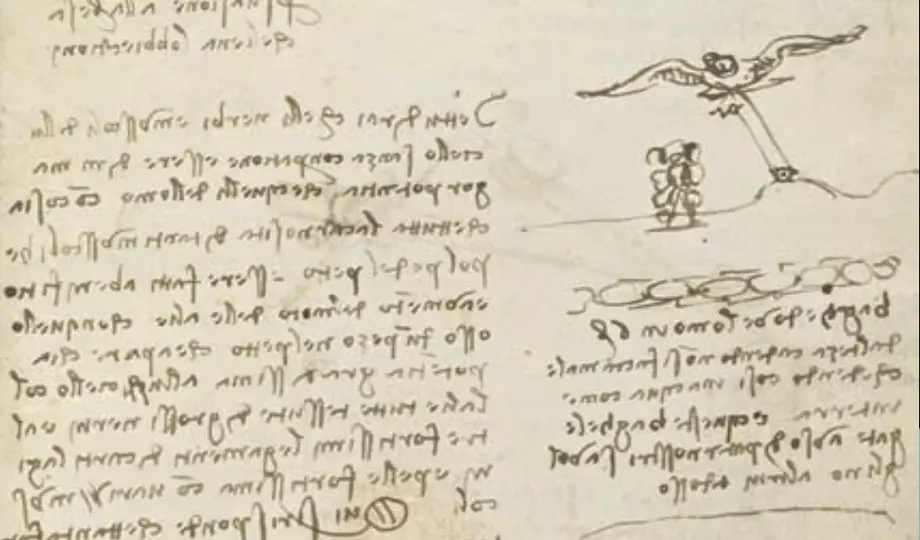
Under the very small sketch, Leonardo wrote: "Leather sacks with which a man falling from a height of 6 arm lengths can avoid hurting himself if he falls into the water or onto the ground.These sacks are to be wrapped around him and tied tightly"
Did Leonardo fly?
In contrast to many of Leonardo's other inventions, one of the flying machines was probably actually built, and there was an attempted flight in 1505 when Leonardo was 53 years old. He noted it with remarkable pathos:
"For the first time, the great bird will rise from the back of the mighty swan. It will fill the whole world with wonder and all writings with its glorious deed, for the eternal glory of the nest where it was born."
With the "back of the mighty swan," he meant Swan Mountain ('Monte Ceceri'), a hill near Florence. The hill drops very steeply on one side, making it ideal for launching a glider. Today, there is a memorial stone there to commemorate Leonardo's attempts. At the foot of the hill lies the town of Fiesole.
The quote is the last sentence in the Codex Turin, Leonardo's book on bird flight. There, he succinctly summarized the principles of flight using bird flight as an example. Leonardo also wrote that he was heading to Fiesole in March 1505. Since the book includes both the dramatic announcement ("the great bird will rise") and technical drawings, it is believed that Leonardo created it in conjunction with a practical flight attempt that took place in Fiesole.
However, the attempt likely failed because the notebook ends at that point, and Leonardo does not mention flight experiments in other writings. Therefore, it is unclear whether there were further flight attempts after the (presumed) failure in Fiesole. Had the experiments been successful, Leonardo would have been the first designer of a glider, 300 years before Otto Lilienthal.
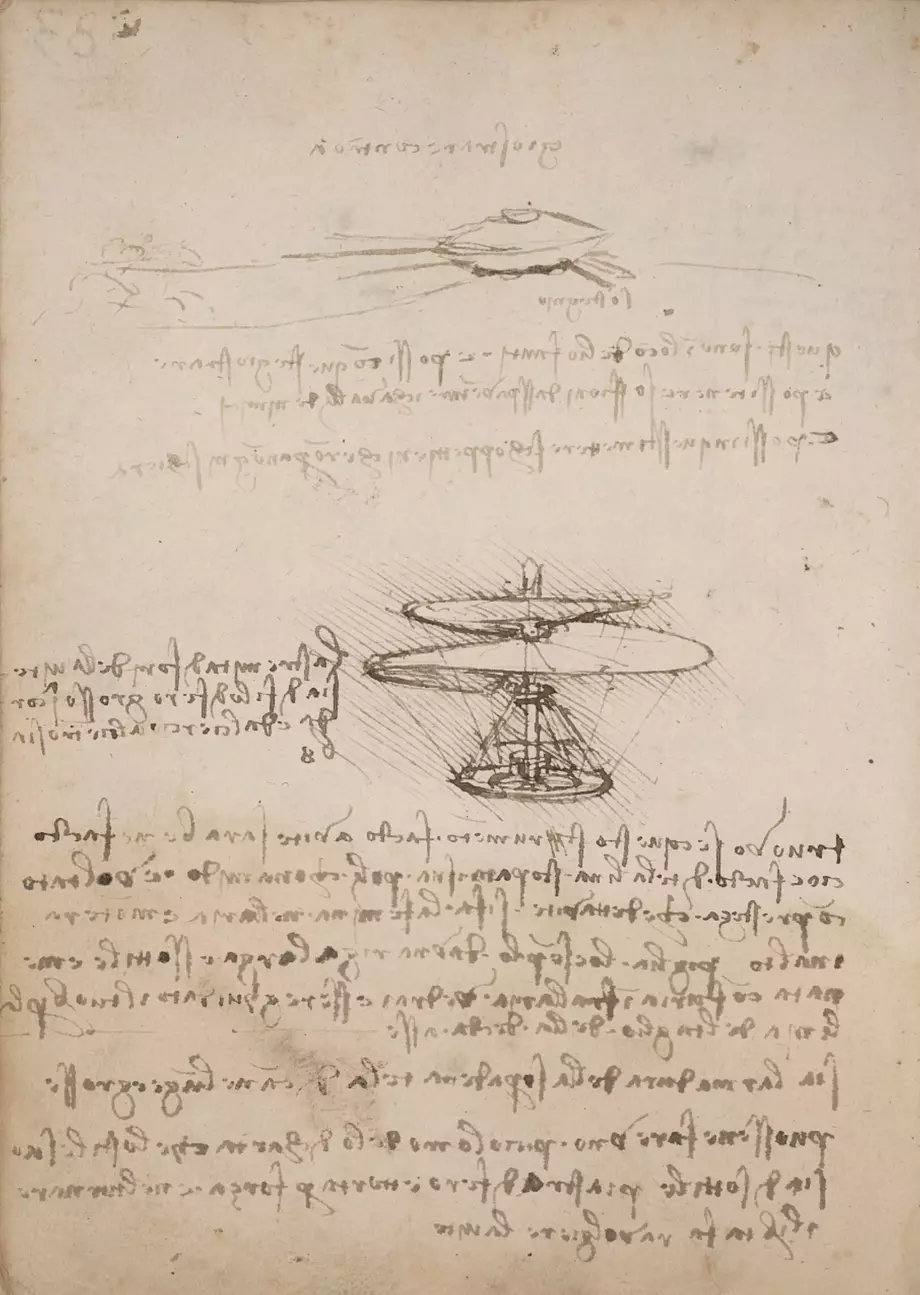
Leonardo's helicopter
Leonardo da Vinci
Study of a flying propeller, Paris manuscripts (manuscript B, folio 83 verso)
around 1487-1490
Pen and ink on paper
23 × 16 cm
Institut de France, Paris
Leonardo's accompanying text
To the left of the illustration
"They take the place of elephants. One can tilt them. You can put bellows in them to terrify the enemy, and you can put carabiniers in them to break up any company."
As with many of his inventions in Milan, Leonardo argued military applications to convince his warlike employer, Ludovico Sforza, to give him the time and resources to make it a reality.
Under the illustration
"The outer end of the screw is made of steel wire of the thickness of a cord, from the circumference to the center it measures eight braccia [about 4m]. I find that this instrument, built with a finely made screw - that is, one made of linen, with the pores well plugged with starch - and nimbly turned, will describe and take off a spiral with said screw in the air. Take the example of a wide and thin ruler whirled rapidly through the air, then notice that your arm is guided by the edge line of said flat surface. The frame for the above-mentioned line should be made of long, strong tube. Make a small model out of cardboard with the axle made of fine steel wire, bend it forcefully, let go and it will drive the screw".

Is Leonardo's flying screw a Chinese invention?
It has been said that Leonardo took the concept of the propeller from a Chinese children's toy. And indeed, the way Leonardo cites the ruler as evidence is reminiscent of a centuries-old East Asian children's toy, a bamboo dragonfly. This toy consists of a ruler-like wooden plate to which a thin stick has been nailed vertically in the center. Because at least one of the wings is tilted slightly upward, the stick can be made to rotate between the palms of the hands and take off.
Leonardo maintained good relations with international travelers, such as Benedetto Dei, who toured Europe, North Africa, and the Orient. Their stories fascinated Leonardo and he listened with interest. Therefore, there exists a description of the Caucasus by Leonardo that seems as vivid as if he had been there himself. Due to the international trade routes and stories in Leonardo's environment, it is therefore quite conceivable that he could have had knowledge of the Chinese toy.
Could Leonardo's helicopter fly?
The helicopter was never built, but it could not have flown at the time. For one thing, the weight of the wooden construction was too high, and for another, it lacked a sufficiently powerful propulsion system to allow the propeller to take off.
Apart from the materials and the drive, however, the principle of lift by means of a propeller was correctly recognized by Leonardo. A replica of the design would be a flyable helicopter with today's means (lightweight construction and electric motor). Therefore, Leonardo's sketch of the propeller is considered the first vertical take-off and landing (VTOL) aircraft ever designed.
Modern adaptations
To mark the 500th anniversary of Leonardo da Vinci's death in 2019, University of Maryland students submitted a design based on Leonardo's propeller principle to a helicopter design competition.
Instead of just one propeller, however, they used four of Leonardo's propellers connected in a square for safety reasons. In their center was the pilot's capsule. For cost reasons, they could only create a mini-drone and a 3D simulation. But the calculations were accurate and so they were able to prove that Leonardo's principle of the propeller basically works. The details can be read on the University of Maryland's website.
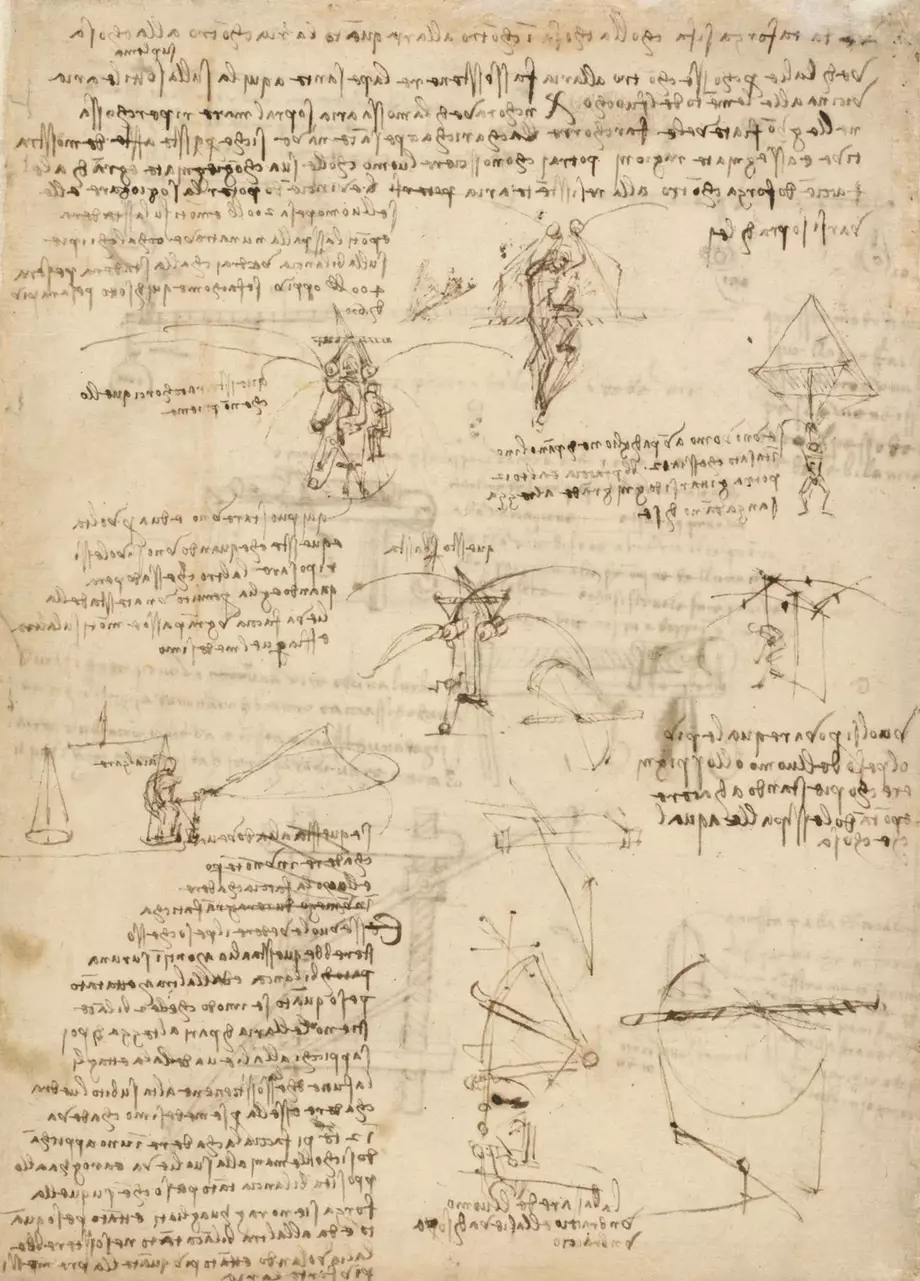
Leonardo's parachute
Leonardo da Vinci
Study of flying machines, Codex Atlanticus (folio 1058 verso)
around 1485
18 × 26 cm
Biblioteca Ambrosiana, Milan
As a marginal note in one of Leonardo's notebooks, there is a depiction of a parachute carrying a human being, only a few centimeters in size. The drawing is on a sheet with thoughts about a flying machine.
Leonardo's accompanying text
"A thing offers as much resistance to the air as the air does to the thing. You can see that the beating of its wings against the air carries the heavy eagle in the highest and thinnest air near the region of fire. Also, you can see the moving air over the sea bouncing back against the billowed sails, thus propelling heavily laden ships forward. By these examples and for the reasons given, one with skillfully joined and large wings can learn to exert force against the resistance of the air, and by conquering it, he can subjugate it and rise above it."
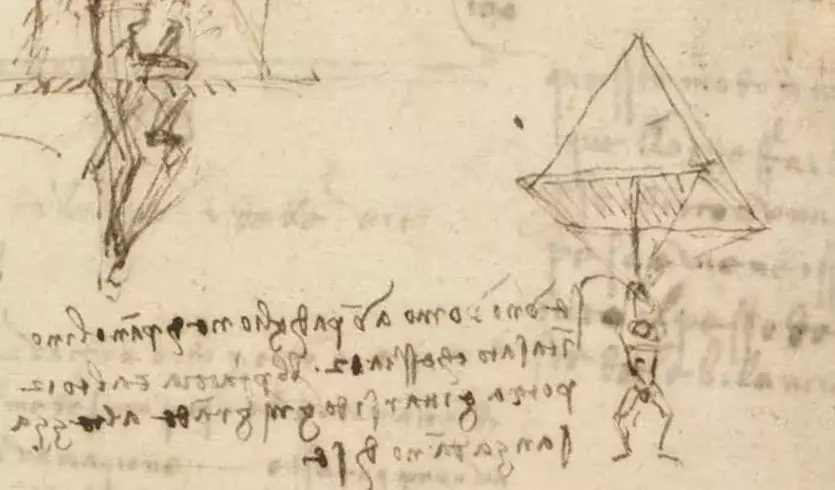
Directly below, Leonardo makes the sketch of the parachute and writes to it:
"If a man has over him a canopy of sealed linen, which shall be twelve cubits wide [about 6m] and twelve high, he will be able to throw himself down from any height, however great, without suffering any harm."
What was the purpose of the parachute?
Leonardo did not invent the parachute as an end in itself; it was related to his attempts at flight. Leonardo was aware that a flying machine had to have an emergency system that could save lives in the event of a crash. The idea for the parachute must have arisen from this consideration. Elsewhere, Leonardo recommends that flight tests be conducted over bodies of water so that the aircraft can still land safely in the event of a sudden descent.
Was the parachute tested?
Leonardo only made this one casual drawing about the parachute. It is unknown whether this flying device was realized during his lifetime.
The flight capability of the drawn parachute was discussed by experts for a long time. On June 26, 2000, the Briton Adrian Nicholas dared a test jump with a parachute made of medieval materials based on this sketch. He let himself be pulled above South Africa's Kruger National Park by a hot air balloon to an altitude of 3000m. Then he released and glided to the ground in a gentle descent. However, after 5 minutes and 2200m of descent, he had to disengage and landed with an additional modern parachute he carried. Leonardo's parachute, weighing about 100kg, is almost four times heavier than modern parachutes. Had Nicholas been unfortunate enough to land, the heavy parachute could have fallen on him and injured him.
After the basic functioning of Leonardo's parachute was proven, there were numerous imitations, many of which were documented on film. Today, they give a dreamlike impression of how far ahead of his time Leonardo was.
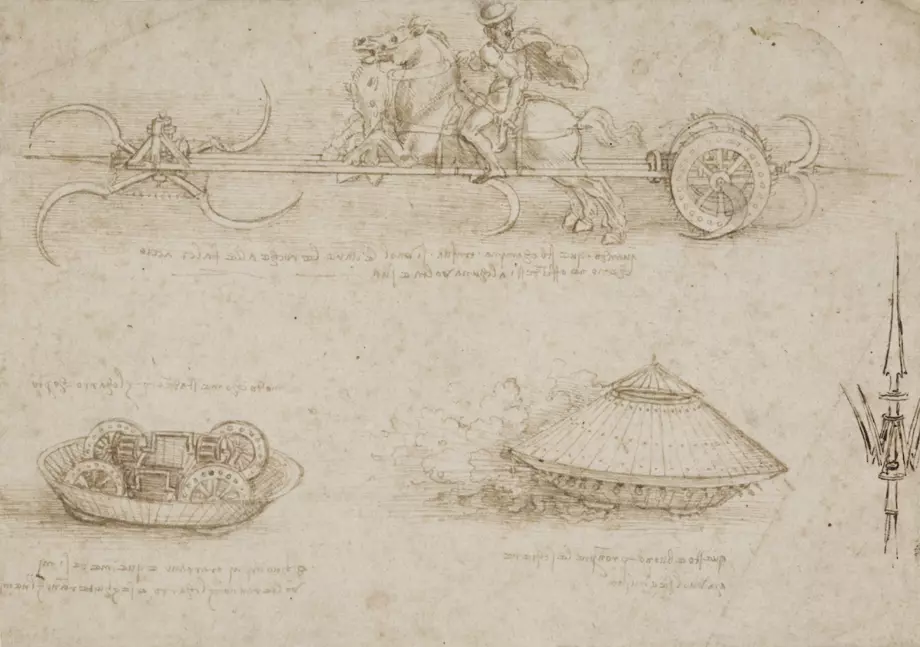
Leonardo's tank
Leonardo da Vinci
Studies of military machines (loose sheet, not assignable to any codex)
around 1485
Pen and brown ink on paper
24,5 x 17,3cm
British Museum, London
Leonardo already mentioned in his famous letter of application to Ludovico Sforza, under point 6, his ability to build armored vehicles:
"Powerful chariots, open, defensive and offensive, equipped with artillery, penetrate into the midst of the enemy. No mass of weapons exists to break them, and close behind, foot soldiers can follow without damage or obstacle."
Leonardo's accompanying text
Above the left interior
"In this way the interior is arranged".
Below
"8 men operate it, and these men also control it and pursue the enemy"
Below the right exterior view
"This is good for breaking through the ranks, but you [the infantry] have to follow".
The tank was never built or used for war purposes.
The famous display error
A peculiarity of the left representation is the crank drive. According to the illustration, the wheels, each driven by a crank, should lock against each other. The crank cannot be moved, the tank cannot drive.
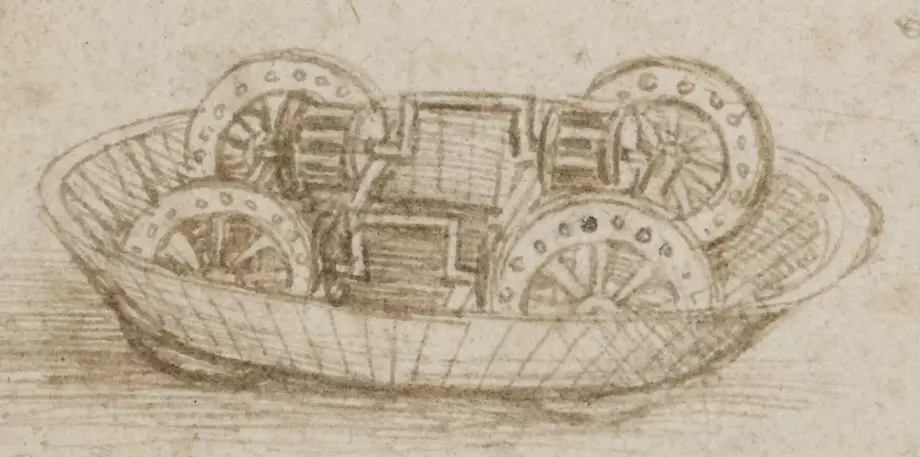
The error is easy to fix. The upper left gear should not be on the right side of the upper left wheel, but on the left side. Then both wheels turn in the same direction
Since Leonardo da Vinci sketched far more complicated gear constructions at other place, this representation mistake surprises. In the research different theories are discussed.
- Leonardo wanted to protect the drawing from imitation. The argument is often also used as an explanation for the use of mirror writing
- Da Vinci had moral scruples and wanted that the, according to this sketch, non-functional tank could never have been used in war. Accordingly, any replica would have produced an immobile model. However, this would have been easy to recognize and fix by an experienced designer
- It may simply have been a clerical error
Functionality
Armor
What was new about Leonardo's design for armor was that the outer armor was sloped at about 30°, which increased the likelihood that enemy bullets could ricochet off the armor, which was presumably made of solid wooden planks. At the same time, the sloped armor improved the tank commander's angle of view of the immediate environment. The commander was supposed to be able to look down on the battlefield from a turret with a 360° viewing slit.
Firepower
The vehicle should be equipped with embrasures all around. There was no fear of smoke from cannons inside the tank, since muzzle-loading cannons were still used at that time, which directed the projectile along with the explosive gases out of the vehicle.
Contrary to what is assumed in modern research, it is not clear that it should be exclusively a gun carriage. This is because cannons, bullets and powder would have made the vehicle too heavy. Also, such a vehicle would have needed far more crew than the planned 8 men.
The drawing itself does not only show cannons. Rather, the side openings may have been openings for musket gunners. This is especially clear in the middle opening, which shows two shotgun barrels lying on top of each other. The smoke drawn by Leonardo also suggests that cannons should have been located only in the front part of the tank.
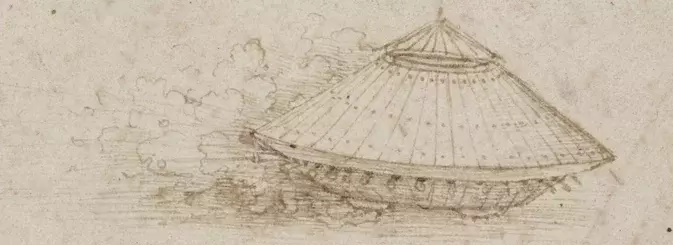
Mobility
The vehicle would have been set in motion by hand cranks connected to the wheels. By adjusting the crank speed on one side as well as the other, the vehicle could have been steered. Also novel was the idea of placing the wheels of the combat vehicle under the armor so that they were less susceptible to destruction and thus threatened maneuverability.
Why did Leonardo invent weapons of war?
Ludovico Sforza was the Duke of Milan and Leonardo's employer from about 1482 to 1499, a period of almost 20 years. The duke was involved in numerous wars and therefore had a great interest in new types of weapons that could give him an advantage on the battlefield. At the court of Milan, Leonardo's duties as court engineer included designing war machines, siege weapons, cannons, mortars, and the like for the duke. Why only a few of Leonardo's ideas were realized is unknown. Possible reasons are
- the high costs due to the mostly costly production, repair and maintenance of the novel weapons
- the duke's soldiers were not used to the tactical use of these weapons, which increased the risk of defeat
- also, only a few of Leonardo's weapons were so devastating in their effect that they could have been decisive in the war
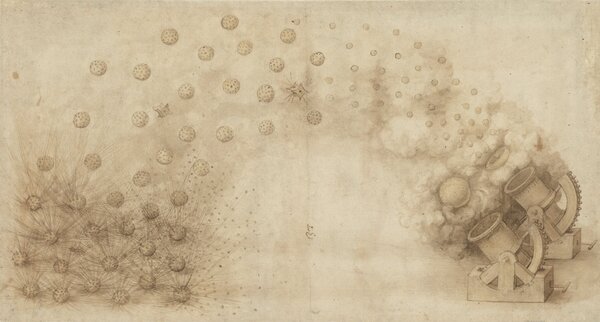
These mortars would have had a particularly devastating effect. The projectiles themselves would have exploded after a short time. Filled with nails, bullets or shells, they would have caused enormous damage, especially if they had exploded while still in the air, as indicated in the upper center of the picture, since the scattering effect is then greater. The invention called cluster munition was first used 200 years later and is now internationally outlawed.
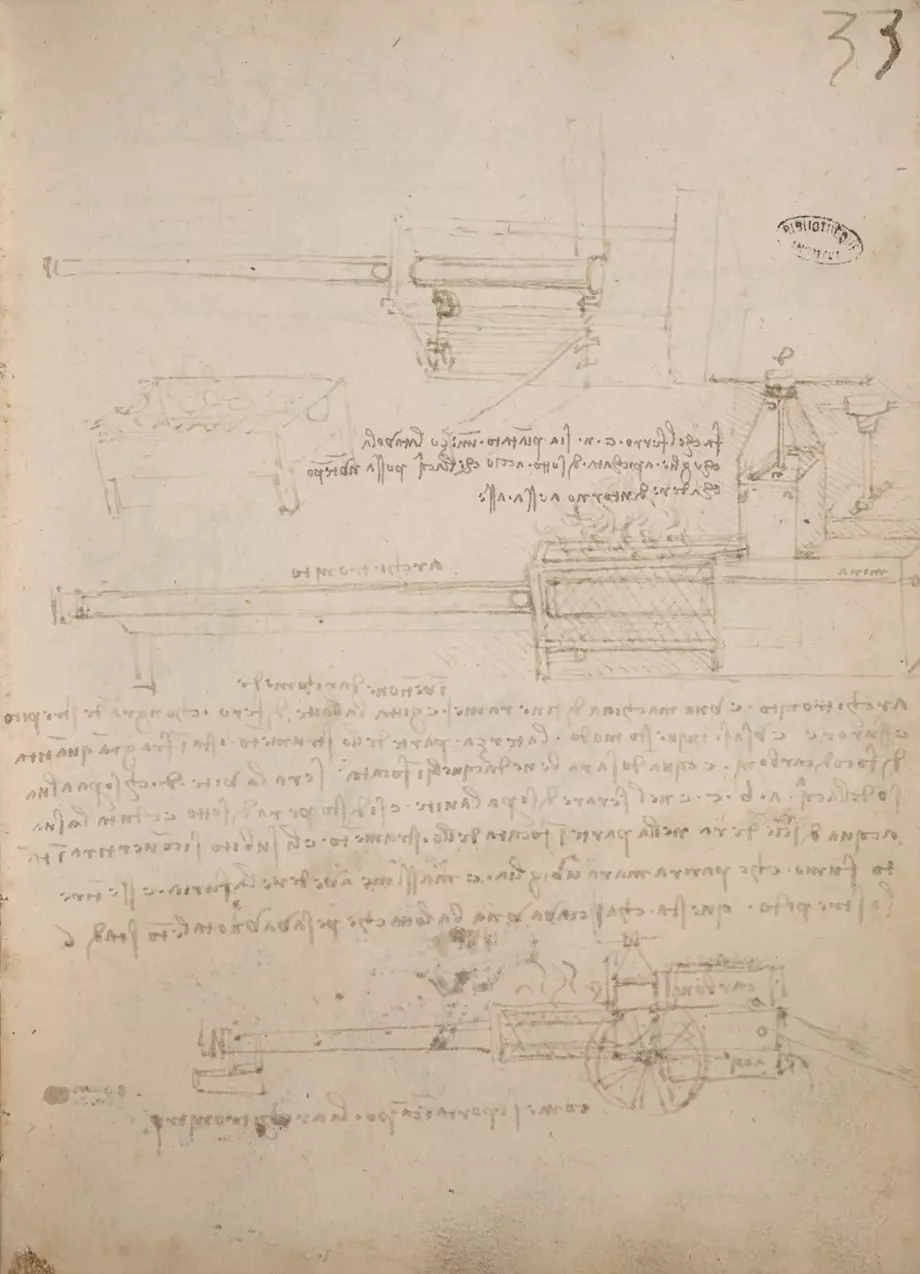
Leonardo's steam cannon
Leonardo da Vinci
Study of a Steam Cannon (Architronito), Paris Manuscripts (Manuscript B, folio 33)
around 1487-1490
Pen and ink on paper
23 × 16 cm
Institut de France, Paris
Leonardo's accompanying text
"The architronito is a fine copper machine, an invention of Archimedes, and it hurls an iron ball with great roar and fury. It is used as follows: The third part of this machine stands in a large quantity of glowing coals, when it has been sufficiently heated by those, it tightens the screw d, which is above the water cistern a b c; and while said screw is tightening, it causes that which is underneath to come loose. And when consequently the water has fallen out, it rushes into the heated part of the machine, and there it is instantly transformed into so much steam that it seems like a miracle, especially when one sees its fury and hears its roaring. This machine has hurled a bullet the weight of a talent six stadia."
How a steam cannon works
A sturdy cannon barrel is needed, which has two openings. One at the front end, where the bullet exits. And a small opening, pointing upward, at the rear end of the cannon barrel. On top of the small opening is a narrow iron tube, which can be closed at the top with a valve. Above the valve is a water inlet. And above it is another valve that is always tightly closed and is only opened for maintenance purposes.
Now a cannonball is placed in the barrel and the rear part of the cannon barrel is heated. As soon as the barrel glows, the upper valve is opened. The water there falls into the glowing hot interior of the tube and evaporates immediately. The sudden pressure build-up of the water, which has turned into steam, can only escape through the cannon tube and the cannonball is ejected with force.
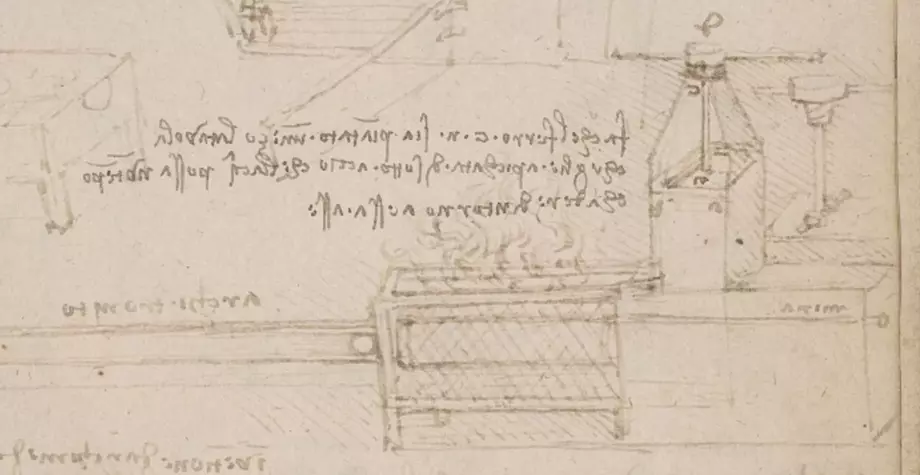
Was the cannon used?
Leonardo writes that this machine hurled a ball the weight of a talent six stadiums. This corresponds to a ball of about 30kg over a distance of about 1.2km.
The ancient units of measurement Leonardo mentions suggest that he did not perform the experiment himself, but refers to the experiments of Archimedes. A military use at the time of the Renaissance is not known.
The cannon has the advantage over conventional cannons in that it works without gunpowder. However, it cannot be used in the rain, which makes it unsuitable for military use. Nevertheless, the idea was taken up again by some military men in the 18th century, but these attempts did not go beyond prototypes.
The essential insight that Leonardo gained here, however, was another. Leonardo was constantly searching for powerful sources of propulsion for his mechanical machines. The power that could be generated by emerging water vapor in a pressure vessel must have made a great impression on him. This principle was the basis for the civilian harnessing of steam by steam engines, which 200 years later heralded the industrial revolution.
Archimedes oder Leonardo?
In the accompanying text, Leonardo claims that the cannon was not his invention, but that of the ancient natural scientist Archimedes. However, there are no known sources that attribute the invention of a steam cannon to Archimedes.
Archimedes was not only a very important scientist, but also a resourceful engineer. He lived in the Sicilian coastal city of Syracuse. When it was besieged by the Romans for three years, his inventions inflicted devastating damage on the Roman attackers. Famous are the huge gripping arms with which he could lift and sink entire ships. According to a later tradition, Archimedes also used burning mirrors to ignite the ships of the Romans over long distances. Modern experiments have shown that Archimedes could have done this in principle with the means and knowledge of optics available at the time. Archimedes was killed when the city was taken.
Leonardo possessed some writings of Archimedes and it is obvious that he was in his tradition. Both had in common their work as war engineers. And like Archimedes, Leonardo's interests lay in mechanics, fluid mechanics and optics. However, Archimedes is not known to have been concerned with pressure of water vapor or pressure projectiles. Such an invention would certainly have been used in the long siege of Syracuse and would not have gone unmentioned in contemporary accounts. So it is quite possible that Leonardo dedicated his invention to Archimedes out of respect for the ancient scholars.
Heronsball
At this point, it should not go unmentioned that machines driven by steam pressure were already known in antiquity. Heron of Alexandria lived at the turn of time, about 200 years after Archimedes. He was a mathematician as well as an engineer and designed the Heronsball, an engine that converts the thermal energy of steam into kinetic energy (see Heronsball). It is unknown today whether Leonardo knew the principle of the Heronsball.
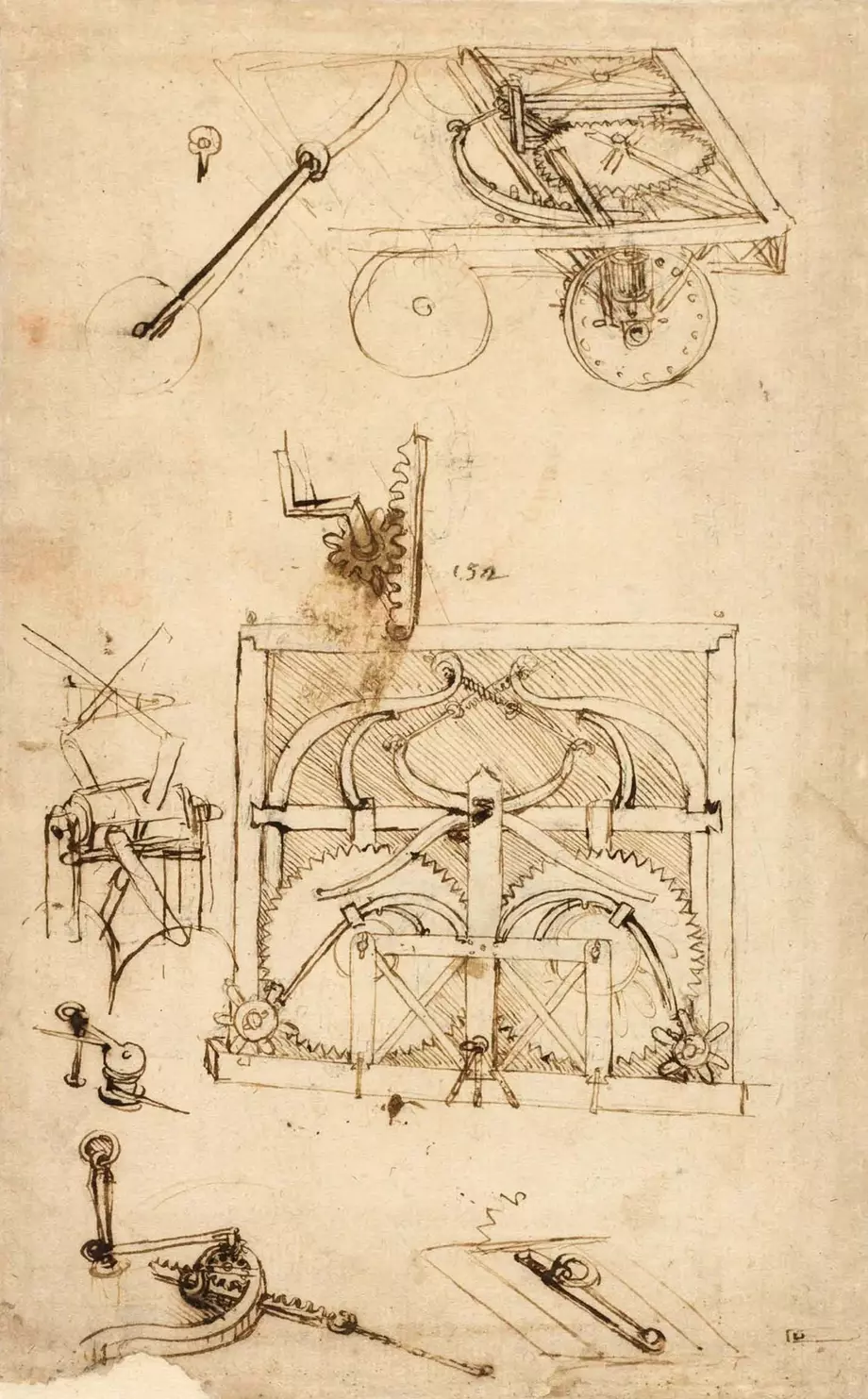
Leonardo's automobiles
Leonardo da Vinci
Study of an automobile with spring drive, Codex Atlanticus (folio 812)
around 1487-1490
Pen and ink on paper
16 × 26 cm
Biblioteca Ambrosiana, Milan
The word automobile is composed of the ancient Greek word for self ('autos') and the Latin word for move ('mobilis'), meaning 'to move oneself'. Therefore, "automobile" in the classical sense does not only mean the car of today.
The wind-up car
Leonardo's wind-up wagon is a three-wheeled vehicle that drives two wheels via a system of gears. How the gear system is set in motion is not clear from the drawing. For this reason, the automobile was long regarded as a study that could not be reproduced. In the meantime, however, it is assumed that the vehicle was wound with spiral tension springs, which must have been located under the two large wheels of the top view. Leonardo's automobile was therefore an oversized wind-up car.
To date, the vehicle has been replicated several times with tension spring drive and it has been shown that, despite a very high dead weight of about 100kg, it can travel up to a hundred meters and reach speeds of up to 50km/h. The vehicle's range is very limited.
Due to its very limited range, it can be assumed that the wind-up wagon may have been a surprise effect for a theatrical performance.
The mechanical lion
The explanation of the drive by means of a wind-up mechanism recalls another of Leonardo's inventions, mentioned by his biographer Vasari:
"At this time the King of France came to Milan, and at his entreaties to make some marvelous thing, he [Leonardo] made a lion that could walk a few steps, and now and then opened its breast, which was full of lilies."
Lilies are both the symbol of the French monarchy and the coat of arms of Florence, Leonardo's hometown. His mechanical lion has not survived and is known only from Vasari's report.
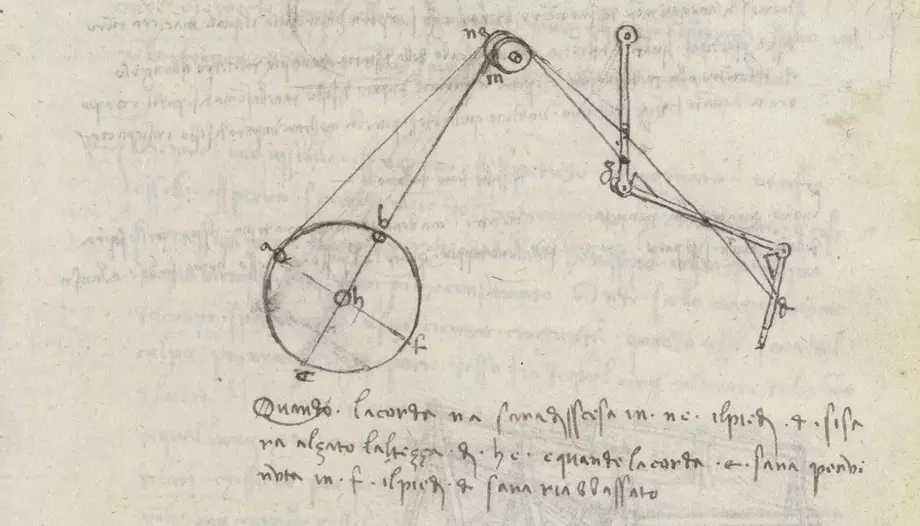
The Leonardo expert Mario Taddei is of the opinion that this sketch could be a reflection on the stepping movement of the mechanical lion.
When the wheel turns, it pulls the levers together with the band, soon together, soon apart, and the limbs move accordingly.
The mechanism suggests that the lion, like the automobile, was designed as a vehicle and that the legs of the lion should move separately
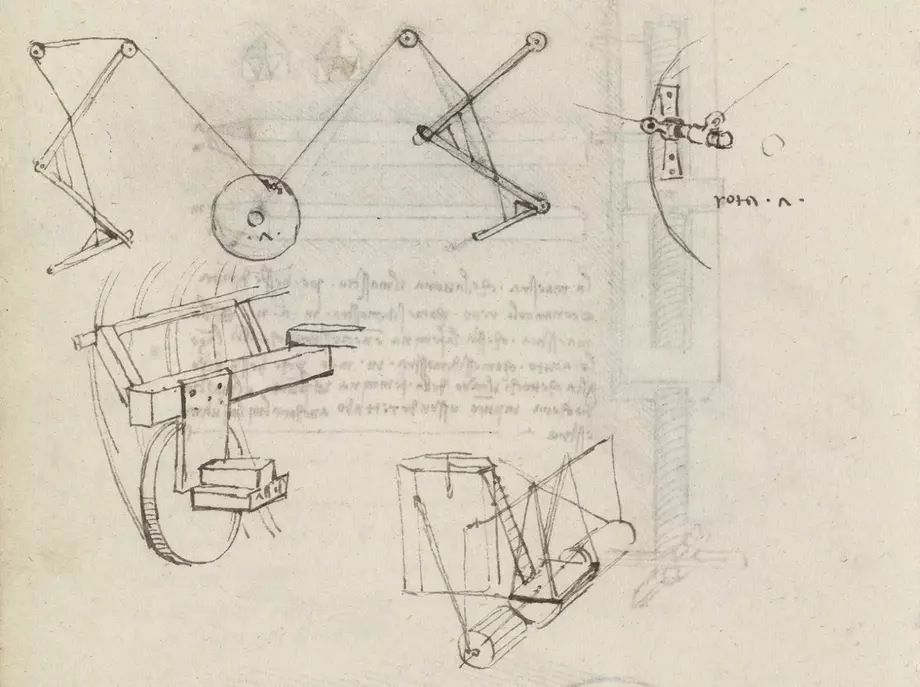
On the next page of the Codex Madrid, two mechanical legs are shown in the upper illustration. Their anatomy corresponds in both cases to the hind legs of a predatory cat. Instead of foreleg and hind leg, two hind legs are shown one behind the other, which is anatomically incorrect. Leonardo knew lions from Florence, where they were kept in the zoo of the city parliament. It could therefore be one of Leonardo's famous mistakes. Below, as on the page before, a wheel can be seen, this time in disguise, which supports the thesis that the mechanical lion was a vehicle with separately moving mechanical limbs
The mechanical knight
Some of Leonardo's sketch sheets suggest that he conceived of a mechanically driven knight. The mechanical knight, like the wind-up car or the mechanical lion, may have been demonstrated at a courtly festival in Milan. However, it is unknown whether the mechanical knight was realized. What became known about its functioning are technical interpretations of three leaves of the Codex Atlanticus (579r, 1021r/v, 1077r). According to these, he could stand up, sit, move his arms, and turn his head. It is also possible that he was able to emit mechanically generated sounds.
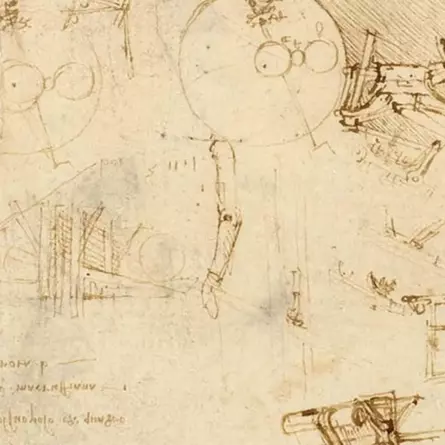
This detail of the sheet shows a mechanical arm
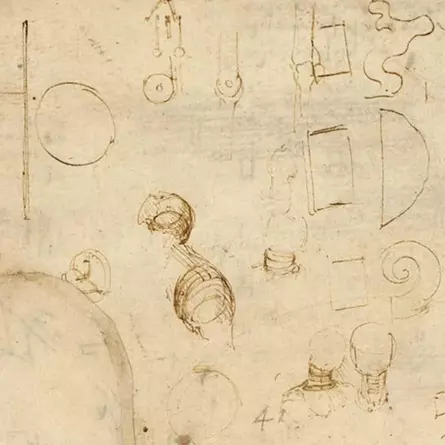
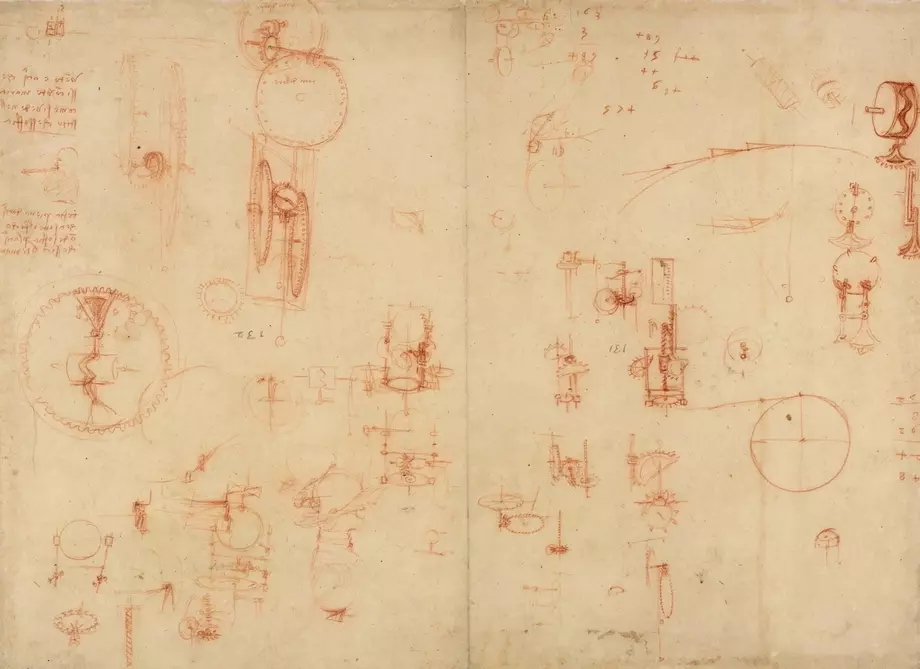
The drum-like cylinder in the upper right corner moves the quarter gear underneath rhythmically back and forth through its undulating indentation. The same mechanism is shown on leaf 579 (below), which also depicts a knight's armor
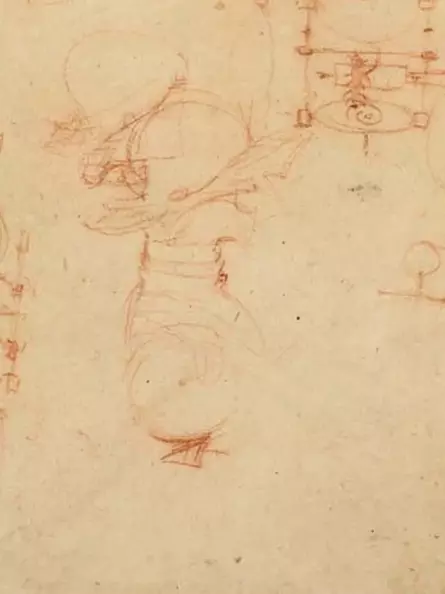
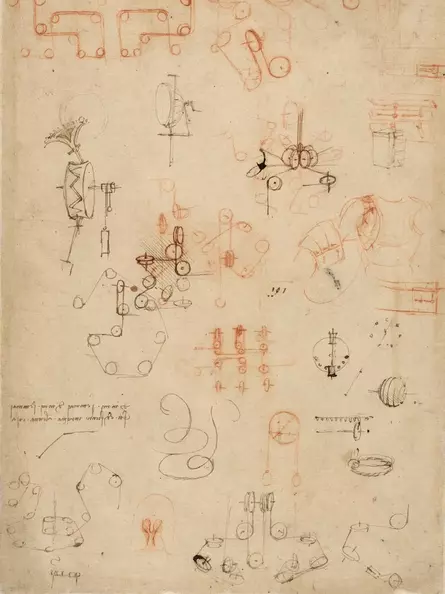
The sketch sheet with pulleys for limbs often serves as a model for replicas. Especially the pulleys in the lower area are understood as joints for the two arms. A knight's armor is in the upper right area. In the upper left area the drum-like cylinder already known from sheet 1077
Conclusion on Leonardo's automobiles
It seems, then, that Leonardo used such automobiles with wind-up mechanisms primarily to entertain his aristocratic patrons at court. They were more mechanical gadgets than serious means of transportation or robots in their own right. In their time, however, such machines were marvels never seen before.
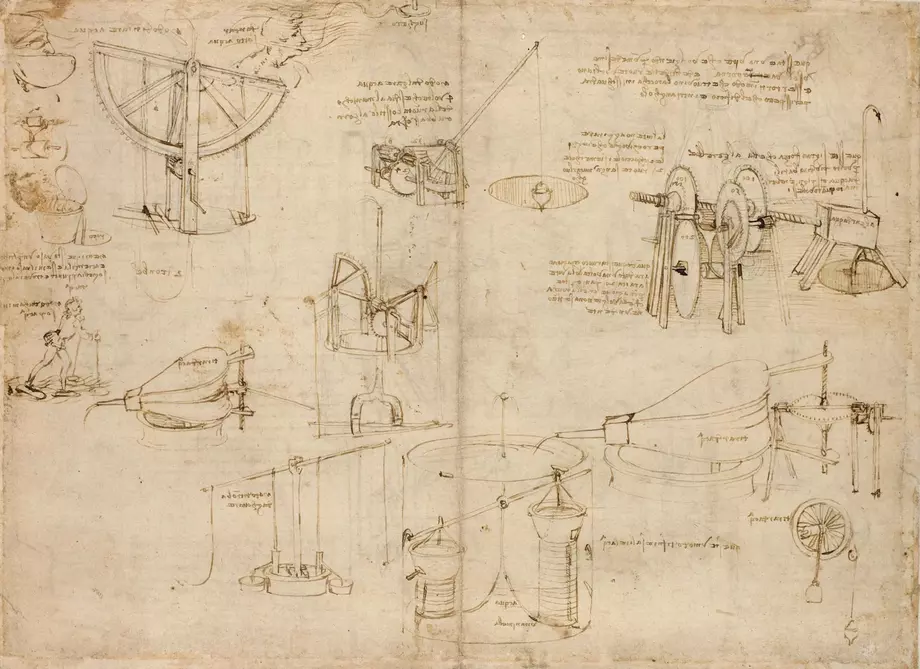
Leonardo's water strider
Leonardo da Vinci
Study sheet with hydraulic and mechanical devices, Codex Atlanticus (folio 26)
around 1485
36 × 26 cm
Biblioteca Ambrosiana, Milan
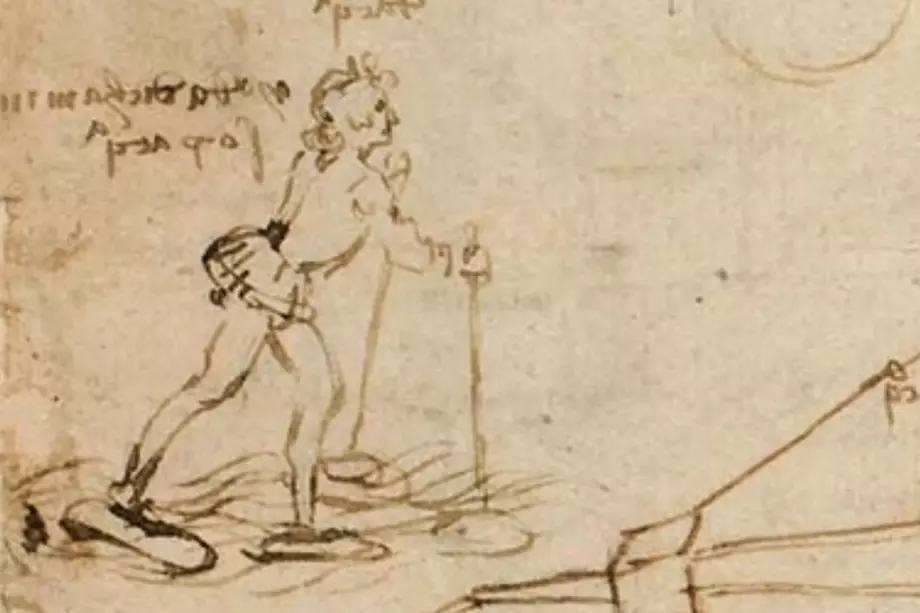
Walk on water
Leonardo uses for his water course the principle of buoyancy that every swimmer and boater knows, but which was scientifically established only by Archimedes.
According to this principle, the static buoyancy of a body in a medium is as great as the weight force of the medium displaced by the body.
In practice, this means that the shoes of Leonardo's runner must be so large that their volume balances the weight of the runner. That is, the shoes must displace about as many liters of water as the runner weighs in kg.
Example calculation: A person weighing approx. 80 kilos needs two waterproof shoes, each 20 cm high, 20 cm wide and 1 m long. Together, both shoes displace about 80 liters.
In order to keep the volume of the shoes as small as possible and thus practical, the shoes should be precisely matched to the weight of the runner. They must be waterproof at the top so that they cannot fill up with water. The water should also be as calm as possible. The arm supports are used to maintain balance. These also have water shoes. Such a water run would then be comparable to skiing. Experienced water skiers can do without the arm supports.
As with many of Leonardo's inventions, it is unclear whether a water course was realized.
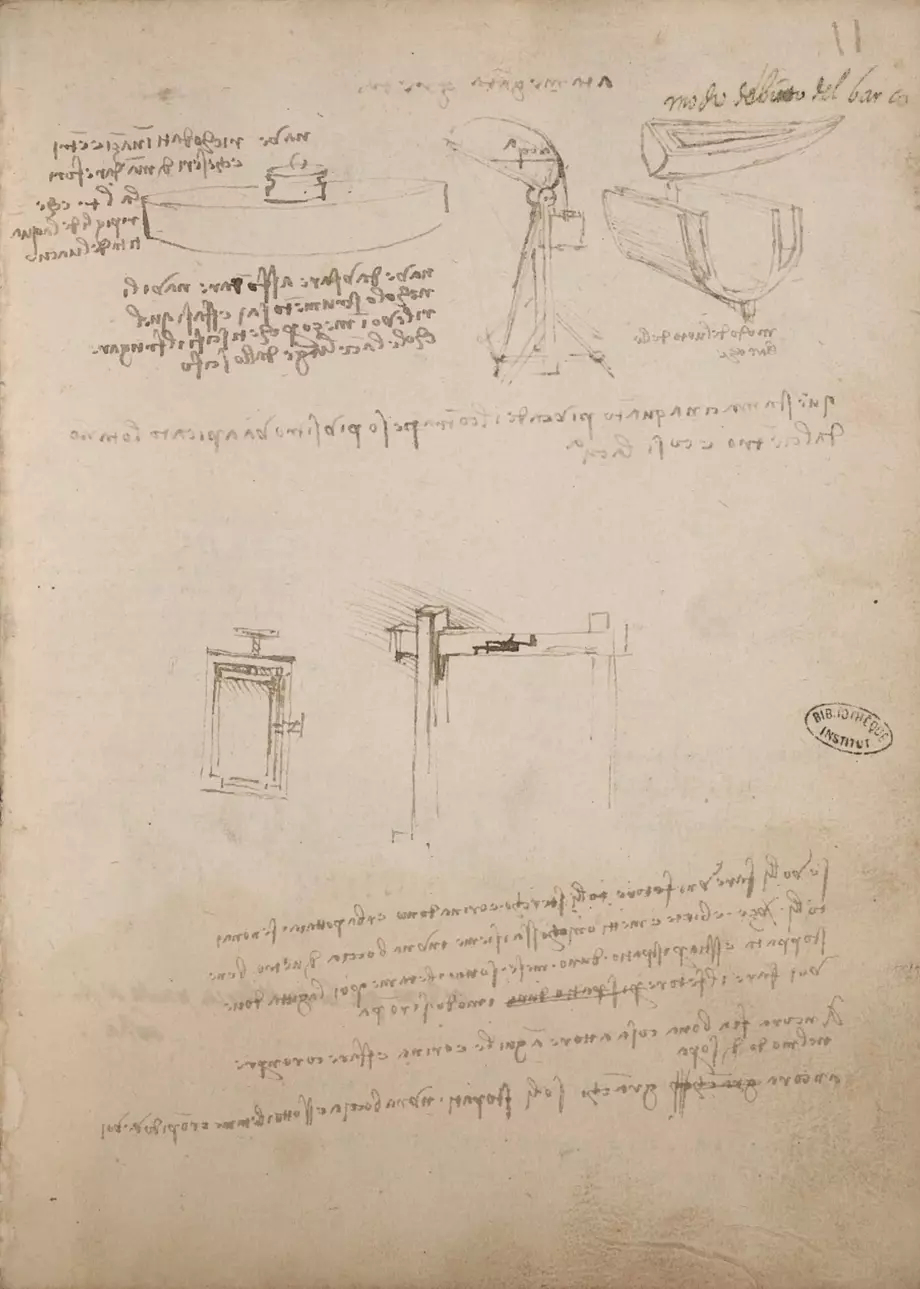
Leonardo's submarine
Leonardo da Vinci
Studies on an unsinkable boat, Paris manuscripts (manuscript B, folio 11)
around 1487-1490
Pen and ink on paper
16 × 23 cm
Institut de France, Paris
Leonardo is widely considered the inventor of the submarine. His submarine already has the typical appearance of today's submarines: streamlined hull and a turret top for surface travel. At the top right of the sheet, Leonardo shows the double-walled side hulls. If they are filled with water, the boat sinks. If the water is squeezed out, the boat rises. Modern submarines still function according to the same principle. In his sketch, Leonardo separates the hollow chambers of the side hulls from those in the bow and stern. By flooding the bow and stern chambers, the submarine can be tilted horizontally.
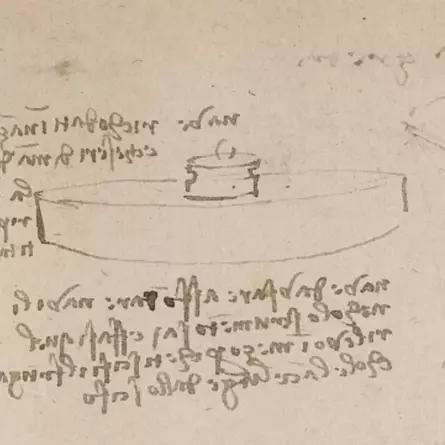
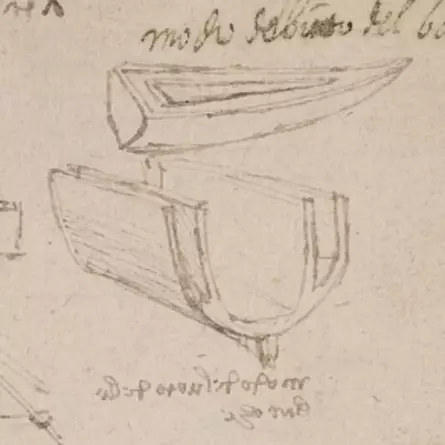
What the design lacks at this point are control devices, a drive, and an indication of exactly how the water level in the side chambers is regulated.
That Leonardo had the necessary pumps to force the water back out of the side chambers is proven by two sketches on the already known sheet with the water runner. In addition, Leonardo constructed several devices that would allow the water in the intermediate walls to be pumped out.
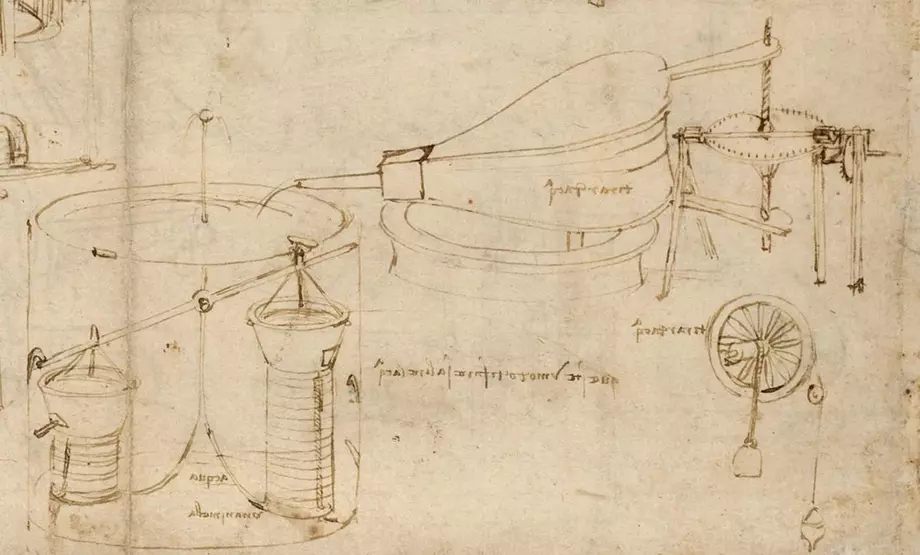
The sheet, already known from the water strider, also shows a device for pumping water from one vessel to another
So far Leonardo's submarine is able to swim, to dive and to rise again. As in the first "real" submarines, a conventional candle could serve as a light source in the dark vehicle, even if this consumed additional oxygen. Several hours would have to pass before the breathing air in the submarine would run out. In principle, a submarine could be operated with only one person, as can be seen in the example of the Turtle.
The Turtle
Leonardo's mental achievement becomes clearer when his submarine is compared with the first realized submarine, the US "Turtle". The already fully functional underwater vehicle was used in the American War of Independence about 250 years after Leonardo's death. Its purpose was to sink enemy ships with explosive charges.
In the principle of the diving process it does not differ from Leonardo's submarine. It has a cavity in the bottom that is filled with water when diving is required and can be emptied with pumps when the submarine is to rise again. In addition, the Turtle has only a hand crank that uses a propeller for propulsion, plus a rudder that can be used to steer left and right.
Given Leonardo's extensive mechanical knowledge, it would be naïve to think he had no idea to steer his underwater vehicle to the left and right, or to attach a rotor with a hand crank for locomotion. Leonardo's knowledge of the rotor principle as a driving force is shown a little later in his model of the helicopter, which is in the same notebook as the submarine. The drawing of the submarine was the first (folio 11 vs folio 83).
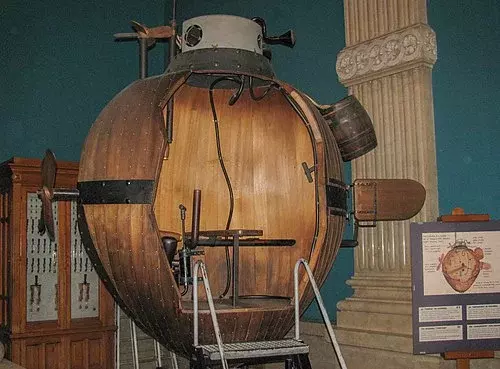
The first submarines were by no means as complex as today's, and in fact the operation of a submarine can be traced back to only a few components, as can be clearly seen here. Leonardo's sketch was missing the rotor (left) and the rudder (right).
@photographed by Zenit, 2009, creativecommons.org/licenses/by-sa/3.0/deed.de)
Why was Leonardo's submarine not realized?
Leonardo's sense of social responsibility is often cited here. Having a submarine fleet would certainly have meant naval supremacy at that time. No fleet could have done anything against this kind of warfare. Submarines could not be effectively countered until the beginning of the 20th century. At that time, sonar equipment began to be developed that could detect submarines underwater and then target them for bombardment.
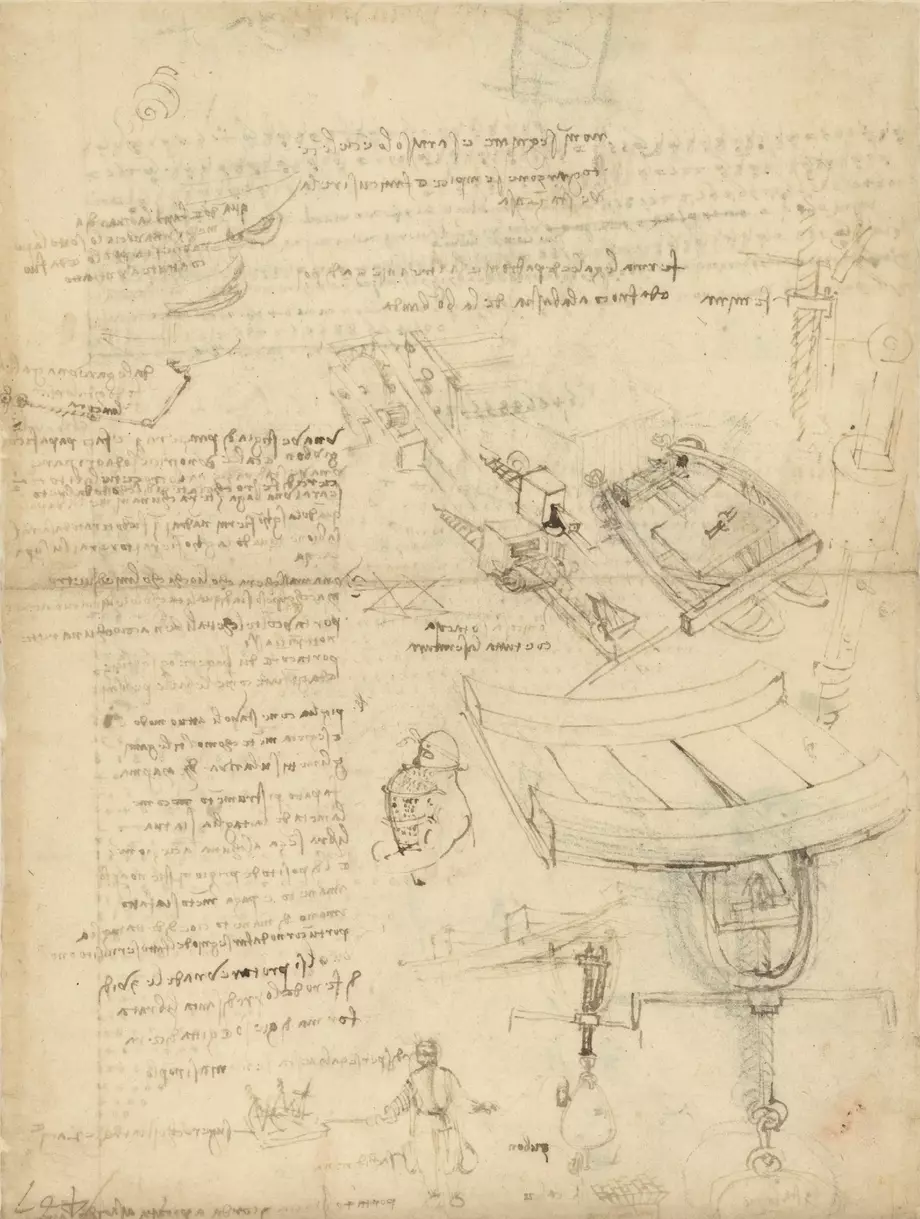
Leonardo's diving suit
Leonardo da Vinci
Study sheet for naval warfare, (Codex Atlanticus, folio 909 verso)
around 1485-87
Pen and ink on paper
Biblioteca Ambrosiana, Milan
How it works
The diving suit consisted of a waterproof full-body suit made of leather with sewn-in glass openings for the eyes. In the drawing, the diver wears two larger weights over his shoulders to enable him to walk on the seabed.
To be able to supply the diver with breathing air, Leonardo wanted to use an oversized snorkel. Floating on the surface of the water was a buoy made of cork, from which two breathing tubes led to the diver's head. The two tubes - one for inhaled air, the other for exhaled air - consisted of several sturdy pipes connected by elastic joints. The joints, covered with a waterproof fabric, were reinforced internally by spirally twisted wire or the like, and thus kept open so as not to be compressed by water pressure. Such a hose system, allowed the diver some freedom of movement. How exactly the valve for separating fresh and used breathing air worked is not clear from the drawing.
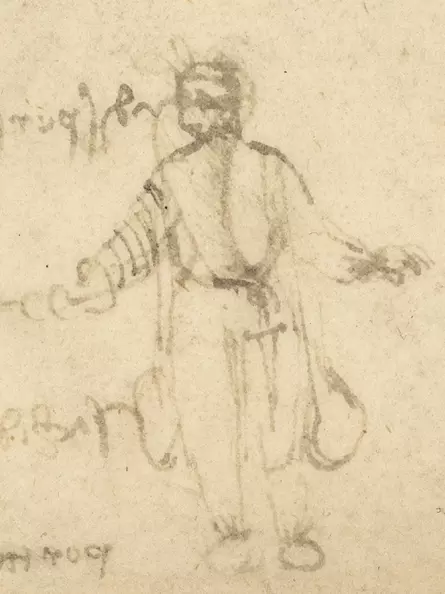
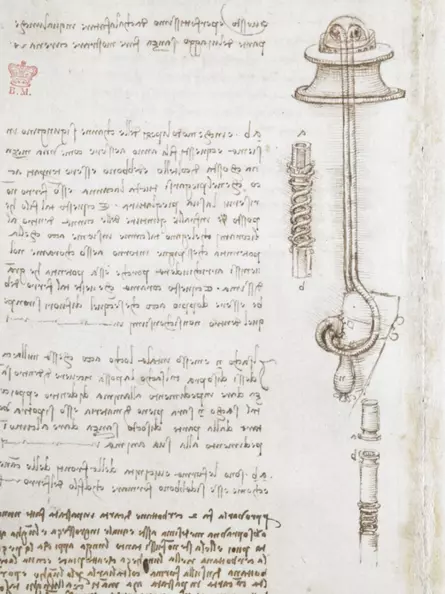
Above, the cork buoy floating on the water surface with two tubes leading to the diver's face. On the left the connections of the breathing tubes reinforced with spirals.
Possible applications
The diving suit, in addition to locomotion in the air, on land, and on water, now made locomotion underwater possible. But Leonardo, in addition to a civilian use, certainly thought of a military use of the submarine innovations, because on the same sheet to the right of the diver is a device for drilling into ships to sink them. Typically for Leonardo, he also gives hints to defend against this, e.g. by double ship's hulls, whereby the outer one should only serve as a shield against such attacks and was separated from the inner one by a hollow space.
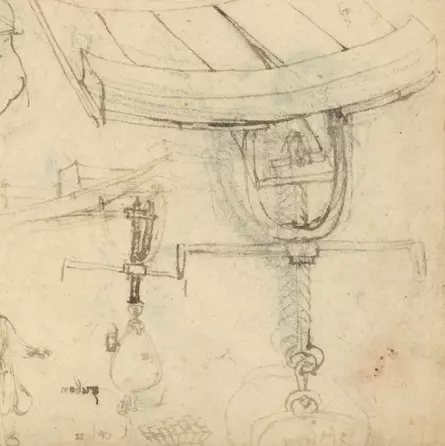
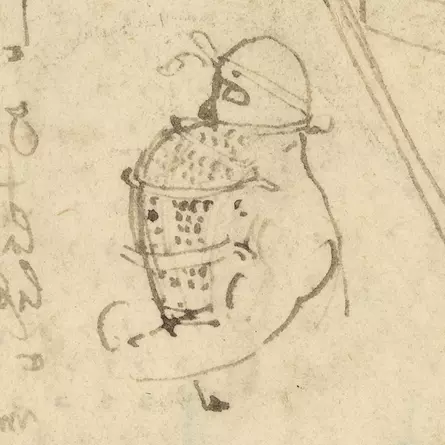
Does Leonardo's diving suit work?
Leonardo's diving suit was never manufactured. Leonardo's employer, the Duke of Milan, had no direct access to the sea and so there was no need for the invention for him, if he knew about it at all. For elsewhere Leonardo notes that he had found a way to sink ships unseen, but he wished to keep this a secret because the potential uses were too devastating. Presumably he was referring to the ideas on this sheet.
The BBC made a replica of the diving suit as part of a documentary on Leonardo's inventions, and with the assistance of professional divers was able to show that the principles of Leonardo's diving suit basically worked.
Did Leonardo invent the wetsuit?
Leonardo was not the first to design a diving suit. He collected the ideas known at the time and improved them where necessary. His technical innovations included the use of a stable tube system that could better withstand the pressure of the water. The introduction of flexible joints to the tubes to improve freedom of movement was also novel, as was the separation of breathing air by means of a valve.
What makes Leonardo's development of the diving suit so special is that his diving suit does not stand on its own, but is part of a well thought-out system of inventions aimed at enabling the element of water to be explored in greater detail. As with the conquest of the element of air, Leonardo proceeded systematically and designed a device to walk on water, an underwater vehicle, an emergency rescue system and finally created the possibility to walk under water.
The greatest pleasure is the knowledge
Downloads
Sources
Websites of the exhibiting museums: Institute de France, Biblioteca Ambrosiana, British Museum, National Air and Space Museum
Frank Zöllner, Leonardo, Taschen (2019)
Frank Zöllner/ Johannes Nathan, Leonardo da Vinci - Sämtliche Zeichnungen, Taschen (2019)
Martin Kemp, Leonardo, C.H. Beck (2008)
Charles Niccholl, Leonardo da Vinci: Die Biographie, Fischer (2019)
H. Anna Suh, Leonardo da Vinci - Skizzenbücher, Librereo (2019)
Ulrich Magin, Leonardo da Vinci - Die Notizbücher, Nikol (2018)
Highly recommended
Marianne Schneider, Das große Leonardo Buch – Sein Leben und Werk in Zeugnissen, Selbstzeugnissen und Dokumenten, Schirmer/ Mosel (2019)
Leonardo da Vinci, Schriften zur Malerei und sämtliche Gemälde, Schirmer/ Mosel (2011)
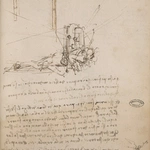
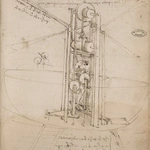
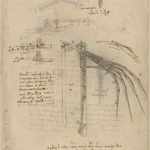
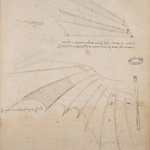
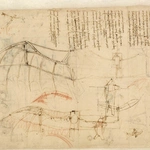
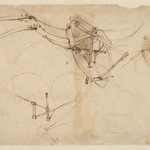
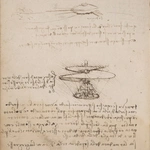
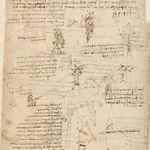
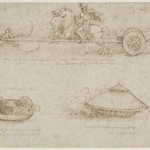
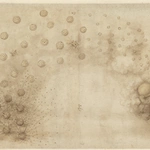
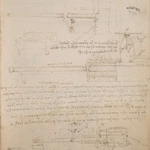
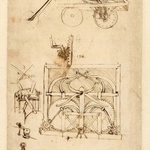
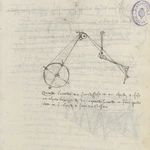
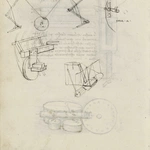
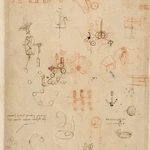
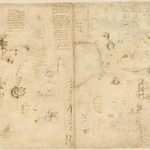
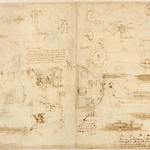

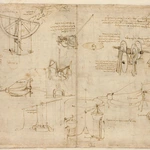
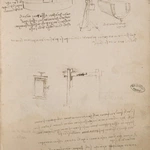
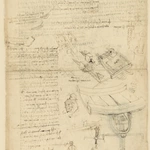
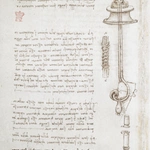
![[Translate to english:] [Translate to english:]](/fileadmin/_processed_/8/b/csm_leonardo-alle-gemaelde_2dc4b01ef6.webp.pagespeed.ce.ohfmgl8OfF.webp)
